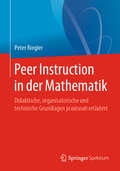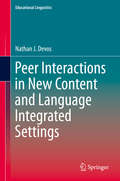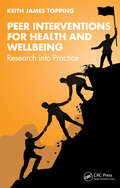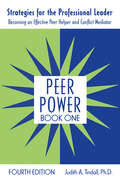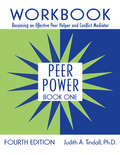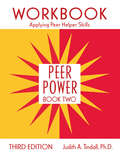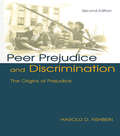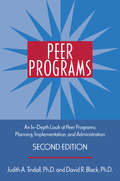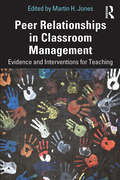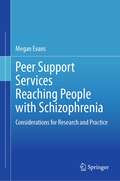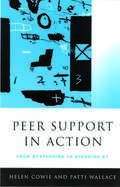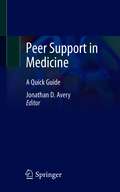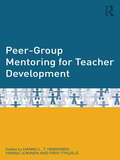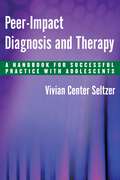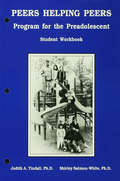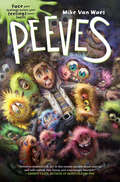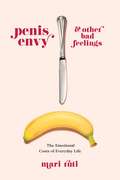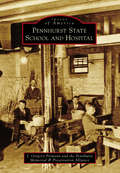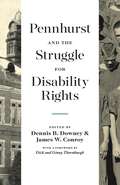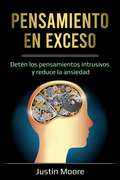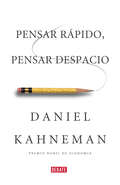- Table View
- List View
Peer Instruction in der Mathematik: Didaktische, organisatorische und technische Grundlagen praxisnah erläutert
by Peter RieglerSie möchten Ihre Lehrveranstaltungen aktivierender und wirksamer gestalten? Sie möchten die Verständnisschwierigkeiten Ihrer Studierenden besser erkennen und verstehen? Sie möchten die studentische Beteiligung steigern, zum Nachdenken und Diskutieren anregen? Lernen Sie das Potenzial von Clickerfragen für die akademische Lehre kennen – damit es bei Ihren Studierenden klick macht! In diesem Buch werden die Grundlagen der interaktiv-dialogischen Lehrmethode praxisnah erläutert. Dabei werden auch häufige Fragen zu didaktischen, organisatorischen und technischen Aspekten beantwortet, etwa:Was ist die Grundidee von Peer Instruction?Wie wirksam ist Peer Instruction? Wie überzeuge ich meine Studierenden davon?Welche technischen Voraussetzungen gibt es?Wie stelle ich gute Clickerfragen?Was sollte ich sonst noch beachten?
Peer Interactions in New Content and Language Integrated Settings
by Nathan J. DevosTrade schools, universities, and programs for international students have begun to experiment with Content and Language Integrated Learning (CLIL) as a viable pedagogy for instruction, as the pedagogy of CLIL increasingly gains recognition as a practical form of language and content education in Europe and beyond, and its application in instructional settings becomes more diverse. Corresponding with CLIL's growth, this book focuses on foreign language use during peer interactions in a new CLIL setting. It particularly concentrates on how to conduct research when the focus is on learner interactions. The theoretical background, research methods, and research instruments are explained in a brief and understandable manner. This book is intended for those interested in CLIL and peer interactions and includes a framework and ideas for investigating new CLIL contexts in a practical manner allowing undergraduate and graduate students to conduct their own research in these settings.
Peer Interventions for Health and Wellbeing: Research into Practice
by Keith James ToppingThis book introduces peer interventions (primarily peer education, peer counselling and peer support) for the positive promotion of health and wellbeing as alternative or parallel methods to traditional clinical processes for reaching hard-to-access populations. It is strongly evidence-based, with chapters discussing reviews of the evidence, followed by important papers with key messages for implementation. Furthermore, it describes implementation and evaluation procedures, both in resource-rich environments and in developing countries.Key Features: Bridges the traditional gap between professional clinical advice and the "real world", reaching where professionals cannot go Brings together information about those interventions that are well evidenced Distils information about how to implement interventions for medical professionals and paraprofessionals and charitable agencies and researchers Presents a fine balance between research and implementation, with evidence-driven guidance
Peer Power, Book One: Strategies for the Professional Leader: Becoming an Effective Peer Helper and Conflict Mediator
by Judith A. TindallThe Peer Power Program is a peer training program designed for middle, high school, and higher education students, focusing on 8 core skills: Attending, Empathizing, Summarizing, Questioning, Genuineness, Assertiveness, Confrontation, and Problem Solving. Through a series of exercises, games, and self-awareness techniques, youth and adults involved in the program can gain the basic communication and mediation skills necessary to effectively help their peers. The professional strategies book provides the program leader/facilitator with clear and easy to follow guidelines for implementing the Peer Power Program. After an overview of the peer program philosophy, training structure, and goals, the leader's guide proceeds through the thirteen Modules that are found in the student Workbook. For each exercise in the student Workbook, this leader's guide provides instructions for introducing and implementing the exercise, time and material requirements, description of its purpose and goal, and application assignments. Equipped with the professional strategies book, the program leader (teacher, school counselor, juvenile center officer, mental health professional and human resource professional) can quickly and confidently work through the Peer Power curriculum.
Peer Power, Book One: Workbook: Becoming an Effective Peer Helper and Conflict Mediator
by Judith A. TindallThe Peer Power Program is a peer training program designed for middle, high school, and higher education students, focusing on 8 core skills: Attending, Empathizing, Summarizing, Questioning, Genuineness, Assertiveness, Confrontation, and Problem Solving. Through a series of exercises, games, and self-awareness techniques, youth and adults involved in the program can gain the basic communication and mediation skills necessary to effectively help their peers. Peer Power, Book One, Workbook brings the participating students through first of all understanding their role as a peer helper, understanding themselves based on much of the Myers Briggs Type Indicator and the Asset Building Model. Next, it takes the participant through eight core skills. The last part of the book indicates strategies for implementing peer work into practice. These strategies include limits setting through ethical guidelines, taking care of themselves, conflict resolving skills and putting peer helping into action. The Workbook provides clear instructions for the skills-focused, guided exercises, in a format that is accessible and enjoyable for students in the Peer Power Program.
Peer Power, Book Two: Workbook: Applying Peer Helper Skills (Routledge Series On Family Therapy And Counseling Ser.)
by Judith A. TindallThe Peer Power Program is a peer training program designed for middle, high school, and higher education students, focusing on 8 core skills: Attending, Empathizing, Summarizing, Questioning, Genuineness, Assertiveness, Confrontation, and Problem Solving. Through a series of exercises, games, and self-awareness techniques, youth and adults involved in the program can gain the basic communication and mediation skills necessary to effectively help their peers. Picking up where Book One left off, the Peer Power, Book Two: Workbook brings the participating students through a series of Modules, focusing on how to apply the core skills learned in the first half of the program in real life situations. This volume covers topics such as drugs and alcohol abuse, taking care of you through stress management, leadership training, tutoring, group work, enhancing sexual health, disordered eating, suicide prevention, coping with loss, highway traffic safety, bullying reduction, mentoring, crisis management, character education, problem gambling prevention, and tobacco prevention.
Peer Power: Workbook: Applying Peer Helper Skills
by Judith A. TindallThe Peer Power Program is a peer training program designed for middle, high school, and higher education students, focusing on 8 core skills: Attending, Empathizing, Summarizing, Questioning, Genuineness, Assertiveness, Confrontation, and Problem Solving. Through a series of exercises, games, and self-awareness techniques, youth and adults involved in the program can gain the basic communication and mediation skills necessary to effectively help their peers. The professional strategies book provides the program leader/facilitator with clear and easy to follow guidelines for implementing the Peer Power Program. Picking up where Book One left off, the leader's guide to Book Two proceeds through the same series of Modules that are found in the Book Two Student Workbook. For each exercise in the student Workbook, this leader's guide provides instructions for introducing and implementing the exercise, time and material requirements, description of its purpose and goal, and application assignments. Equipped with the professional strategies book, the program leader (teacher, school counselor, juvenile center officer, mental health professional, and human resource professional) can quickly and confidently work through the Peer Power curriculum.
Peer Prejudice and Discrimination: The Origins of Prejudice
by Harold D. FishbeinThis award-winning book provides an analysis of the genetic/evolutionary, cultural/historical, and developmental aspects of prejudice and discrimination. It emphasizes how certain genetic/evolutionary mechanisms are utilized to both produce and prevent prejudice and discrimination from occurring or to modify these behaviors once established. The goals of the book are to help us understand the limitations of interventions and increase tolerance and acceptance of outsiders. Peer Prejudice and Discrimination, Second Edition is ideal for advanced-level courses on prejudice and/or discrimination taught in departments of psychology, education, and sociology, as well as a valuable addition to any serious scholars personal library.
Peer Programs: An In-Depth Look at Peer Programs: Planning, Implementation, and Administration
by David R. Black Judith A. TindallThe Peer Power Program is a peer training program designed for middle, high school, and higher education students, focusing on 8 core skills: Attending, Empathizing, Summarizing, Questioning, Genuineness, Assertiveness, Confrontation, and Problem Solving. Through a series of exercises, games, and self-awareness techniques, youth and adults involved in the program can gain the basic communication and mediation skills necessary to effectively help their peers. An overview of peer helping, Peer Programs explains the value of and techniques for helping non-professionals learn to help others one-on-one, in small groups and in groups of classroom size. Intended to be of use to those responsible for planning, implementing and/or administering peer programs, this text should also convince those who are not directly involved that peer helping is a worthwhile undertaking – reducing drug and alcohol abuse, dropouts, violence and conflict, HIV and AIDS, pregnancy, stress and negative peer pressure. New features of this edition include: updated rationale for peer programs updated highlights from current evaluation added professionalism- CPPE. Certified Program, Programmatic Standards, Rubric and others CD of forms to customize for all phases of the Peer Program step-by-step guide of new and current programs This book is an indispensable guide for learning important aspects of training peer helpers and as a resource book for a wide range of professional peer helpers, such as: administrators; managers; teachers; counselors; ministers; religious educators; social workers; psychologists; human resource personnel and others in the helping professions.
Peer Relationships in Classroom Management: Evidence and Interventions for Teaching
by Martin H. JonesPeer Relationships in Classroom Management offers pragmatic, empirically validated guidance to teachers in training on issues pertaining to students’ interpersonal relationships. Concepts such as bullying, popularity, and online friendships are ubiquitous in today’s schools, but what kinds of scientific and pedagogical knowledge can support teachers navigating students’ complex lives? Using real-world examples and case studies, this book helps preservice educators to enhance their knowledge of classroom management by focusing on the interpersonal relationships in their schools. Each chapter includes an accessible approach to understanding the social motives in student’s peer interactions inside school, and how to best intervene when these social interactions become detrimental to learning or cause negative interpersonal interactions.
Peer Support Services Reaching People with Schizophrenia: Considerations for Research and Practice
by Megan EvansMany mental health providers are seeking guidance in designing and improving peer support programs for people with mental illnesses. However, the evidence base in this area is limited by lack of consensus on the core components of peer support. This research provides a comprehensive, nuanced view of peer support reaching people with schizophrenia. Results of a realist review of 355 sources and interviews with experts in the field are presented. Realist review is an approach to evidence synthesis that asks, ‘What works, for whom, and in what circumstances?’ Results include a typology of key functions of peer support (e.g., being there, linkage to clinical care and community resources, systems advocacy, ongoing support), documented benefits (e.g., decreased acute care utilization, increased recovery), and implementation recommendations (e.g., critical mass of peer workers, supportive infrastructure, an organizational recovery orientation). The book is intended for program planners, managers, and researchers.
Peer Support in Action: From Bystanding to Standing By
by Helen Cowie Patti Wallace`It would be of use to adults and teachers who are starting to research peer support and the logistics of adopting such a scheme in their school. It would also be of use to saff who are currently operating a peer support scheme. I personally will use this book and keep a copy in the counselling service library, recommending it to counsellors/trainers and teachers interested or already facilitating peer support in their schools′ - British Journal of Guidance and Counselling `It is to read, comprehensive in its structure and advice and through examples of first-hand experiences, makes the reader feel enthusiastic about trying out different ideas…. An excellent handbook for the manager of a peer support system for any organization′ - Anne Woodhouse, Clinical Child Psychology and Psychiatry Peer support systems are increasingly being used in schools and other youth settings to tackle problems such as bullying, rejection, social exclusion, sexual identity, self-esteem and loneliness. Peer Support in Action is a practical guide which gives adults who work with children and young people the knowledge, understanding and practical tools to provide effective and appropriate systems of peer support. Helen Cowie and Patti Wallace combine insights drawn from practice with up-to-date research findings, to give a sound basis for peer-based interventions. They encourage readers to build on the potential for offering help which many young people have and give practical guidance on how to train, guide and supervise them in supporting their peers. Peer Support in Action is for teachers, educational psychologists, social workers, education welfare officers, counsellors and counselling psychologists and all professionals involved in the pastoral care and guidance of children and young people.
Peer Support in Medicine: A Quick Guide
by Jonathan D. AveryThe book serves as a guide for all clinicians seeking to improve healthcare outcomes by implementing peer support in the treatment and management of medical and mental health conditions. The book begins with a chapter that describes the importance of peers and how peers are increasingly being utilized to improve medical outcomes. Each chapter opens with an introductory section, include tables and figures, and ends with a summary section for quick reference. Written by experts in the field, this resource covers the clinical implications for peer support in substance misuse, chronic medical conditions, in special populations, and mental illness generally. Each chapter is designed specifically to be accessible for a broad clinical audience of experts and non-experts across medical specialties. Peer Support in Medicine is an excellent resource for all clinicians seeking to improve healthcare outcomes using the gains made by the peer support model, including psychiatrists, psychologists, healthcare researchers, and medical students across specialties, nurses, social workers, and all others.
Peer-Group Mentoring for Teacher Development
by Päivi Tynjälä Hannu L.T. Heikkinen Hannu JokinenSupporting new teachers is a common challenge globally and the European Commission has recently emphasised the need to promote a lifelong continuum of teachers professional development by building bridges between pre-service and in-service teacher education.Peer-Group Mentoring for Teacher Development introduces and contextualises for an internati
Peer-Impact Diagnosis and Therapy: A Handbook for Successful Practice with Adolescents
by Vivian Center SeltzerAdolescents are infamous for their rebellious behavior. Indeed,much of the focus of therapy and clinical intervention with troubled adolescents focuses on their presumed need to rebel against their parents as they define their own identities. Yet psychologist Vivian Center Seltzer argues that approaching work with adolescent clients with this presumption in mind is likely to miss the roots of their problem behavior.Rather than acting out against parental authority, adolescents in need of clinical help are most often dealing with their disappointing comparisons with their peers—the most relevant others to them during this period of their development. Seltzer explains that it is countless interactions with their peers, at school and elsewhere outside of the home, that are the primary mode of psychological and social development for adolescents. Practitioners must recognize this crucial influence, and perhaps forgo traditional approaches, in order to better work with their adolescent clients.Peer-Impact Diagnosis and Therapy is a practical professional guide for how to approach and aid troubled teens by accessing the wealth of insight to be gained from understanding the influence of peer interactions on development and on behavior. Full of diagnostic categories and protocols for use with all types of adolescents, as well as guidance, tips, case studies, and offering a targeted model for adolescent group therapy, Seltzer provides professionals with all the tools they need to assist teens on their road to adulthood.
Peer-assisted Learning: A Practical Guide For Teachers
by Keith Topping Stewart EhlyPeer Assisted Learning (PAL) involves children in school consciously assisting others to learn, and in so doing learning more effectively themselves. It encompasses peer tutoring, peer modeling, peer education, peer counseling, peer monitoring, and peer assessment, which are differentiated from other more general "co-operative learning" methods. PAL is not diluted or surrogate "teaching"; it complements and supplements (but never replaces) professional teaching--capitalizing on the unique qualities and richness of peer interaction and helping students become empowered democratically to take more responsibility for their own learning. In this book, PAL is presented as a set of dynamic, robust, effective, and flexible approaches to teaching and learning, which can be used in a range of different settings. The chapters provide descriptions of good practice blended with research findings on effectiveness. They describe procedures that can be applied to all areas of the school curriculum, and can be used with learners of all levels of ability, including gifted students, students with disabilities, and second-language learners. Among the distinguished contributors, many are from North America, while others are from Europe and Australia. The applicability of the methods they present is worldwide. Peer-Assisted Learning is designed to be accessible and useful to teachers and to those who employ, train, support, consult with, and evaluate them. Many chapters will be helpful to teachers aiming to replicate in their own school environments the cost-effective procedures described. A practical resources guide is included. This volume will also be of interest to faculty and researchers in the fields of education and psychology, to community educators who want to learn about the implications of Peer Assisted Learning beyond school contexts, and to employers and others involved in post-school training.
Peers Helping Peers: Programs For The Preadolescent
by Judith A. Tindall Shirley SalmonFirst published in 1990. Routledge is an imprint of Taylor & Francis, an informa company.
Peeves
by Mike Van Waes“Gremlins meets Inside Out in this sneaky parable about courage and self-control. Fun, funny, and surprisingly heartfelt."—Ernest Cline, author of Ready Player OneSteven (Slim) Pickings is on the edge of a breakdown—but then, it always feels like Slim is teetering on the edge of something. The difference this time is that something’s caused Slim’s worries to come alive!He’s set loose a bunch of annoying, pesky, outrageously contagious creatures—and they’re infecting everyone they meet and massing to take over the town! Slim’s problems began when he and his sister, Lucy, visited their dad's work and Slim was hit in in the face with an experimental medicine, a previously not-yet-human-tested anti-anxiety spray called Personal Vexation Zoners, PVZ. No one knew the side effects before, but certainly none of the experts imagined that the spray would cause anyone infected to literally sneeze out their biggest peeves.Now Slim and the rest of the town are trailed by the things that annoy them most. Noisy Peeve, Lazy Peeve, Asking Peeve—they all stick with Slim at all times and left untreated, they’re quickly getting worse and way, way more destructive.To stop them, Slim will have to do more than just team up with his family and friends—he’ll have to face his fears, literallyDebut author award-winning screenwriter Mike Van Waes brings original intelligence and wit to a magical coming-of-age story in Peeves, where you have to face your feelings before your feelings have faces.
Penis Envy and Other Bad Feelings: The Emotional Costs of Everyday Life
by Mari RutiMari Ruti combines theoretical reflection, cultural critique, feminist politics, and personal experience to analyze the prevalence of bad feelings in contemporary everyday life. Proceeding from a playful engagement with Freud’s idea of penis envy, Ruti’s autotheoretical commentary fans out to a broader consideration of neoliberal pragmatism. She focuses on the emphasis on good performance, high productivity, constant self-improvement, and relentless cheerfulness that characterizes present-day Western society. Revealing the treacherousness of our fantasies of the good life, particularly the idea that our efforts will eventually be rewarded—that things will eventually get better—Ruti demystifies the false hope that often causes us to tolerate an unbearable present.Theoretically rigorous and lucidly written, Penis Envy and Other Bad Feelings is a trenchant critique of contemporary gender relations. Refuting the idea that we live in a postfeminist world where gender inequalities have been transcended, Ruti describes how neoliberal heteropatriarchy has transformed itself in subtle and stealthy, and therefore all the more insidious, ways. Mobilizing Michel Foucault’s concept of biopolitics, Jacques Lacan’s account of desire, and Lauren Berlant’s notion of cruel optimism, she analyzes the rationalization of intimacy, the persistence of gender stereotypes, and the pornification of heterosexual culture. Ruti shines a spotlight on the depression, anxiety, frustration, and disenchantment that frequently lie beneath our society’s sugarcoated mythologies of self-fulfillment, romantic satisfaction, and professional success, speaking to all who are concerned about the emotional costs of the pressure-cooker ethos of our age.
Pennhurst State School and Hospital (Images of America)
by J. Gregory Pirmann Pennhurst Memorial & Preservation AllianceFor nearly 80 years, Pennhurst State School and Hospital was a reminder of how society viewed and treated people with intellectual disabilities. Over its existence, Pennhurst was home to more than 10,600 people. Many spent decades there, working to keep the institution running by performing various jobs. While some enjoyed the lives they had fashioned for themselves at Pennhurst, for many others, life there was crushing. Pennhurst also played a central role in the lives of its employees and in the rural Pennsylvania community where it was located. Controversy plagued the institution for its entire existence, and it is remembered primarily as a place where bad things happened. However, it was much more than that. This book provides a window into that separate world, reminding those who were part of it of what they saw and did there and giving those who know only what they have heard or seen a different picture of what Pennhurst truly was.
Pennhurst and the Struggle for Disability Rights (Keystone Books)
by Dennis B. Downey James W. ConroyConceived in the era of eugenics as a solution to what was termed the "problem of the feeble-minded," state-operated institutions subjected people with intellectual and developmental disabilities to a life of compulsory incarceration. One of nearly 300 such facilities in the United States, Pennhurst State School and Hospital was initially hailed as a "model institution" but was later revealed to be a nightmare, where medical experimentation and physical and psychological abuse were rampant. At its peak, more than 3,500 residents were confined at Pennhurst, supervised by a staff of fewer than 600.Using a blended narrative of essays and first-person accounts, this history of Pennhurst examines the institution from its founding during an age of Progressive reform to its present-day exploitation as a controversial Halloween attraction. In doing so, it traces a decades-long battle to reform the abhorrent school and hospital and reveals its role as a catalyst for the disability rights movement. Beginning in the 1950s, parent-advocates, social workers, and attorneys joined forces to challenge the dehumanizing conditions at Pennhurst. Their groundbreaking advocacy, accelerated in 1968 by the explosive televised exposé Suffer the Little Children, laid the foundation for lawsuits that transformed American jurisprudence and ended mass institutionalization in the United States. As a result, Pennhurst became a symbolic force in the disability civil rights movement in America and around the world.Extensively researched and featuring the stories of survivors, parents, and advocates, this compelling history will appeal both to those with connections to Pennhurst and to anyone interested in the history of institutionalization and the disability rights movement.
Pennhurst and the Struggle for Disability Rights (Keystone Books)
by Dennis B. Downey James W. ConroyConceived in the era of eugenics as a solution to what was termed the “problem of the feeble-minded,” state-operated institutions subjected people with intellectual and developmental disabilities to a life of compulsory incarceration. One of nearly 300 such facilities in the United States, Pennhurst State School and Hospital was initially hailed as a “model institution” but was later revealed to be a nightmare, where medical experimentation and physical and psychological abuse were rampant. At its peak, more than 3,500 residents were confined at Pennhurst, supervised by a staff of fewer than 600.Using a blended narrative of essays and first-person accounts, this history of Pennhurst examines the institution from its founding during an age of Progressive reform to its present-day exploitation as a controversial Halloween attraction. In doing so, it traces a decades-long battle to reform the abhorrent school and hospital and reveals its role as a catalyst for the disability rights movement. Beginning in the 1950s, parent-advocates, social workers, and attorneys joined forces to challenge the dehumanizing conditions at Pennhurst. Their groundbreaking advocacy, accelerated in 1968 by the explosive televised exposé Suffer the Little Children, laid the foundation for lawsuits that transformed American jurisprudence and ended mass institutionalization in the United States. As a result, Pennhurst became a symbolic force in the disability civil rights movement in America and around the world.Extensively researched and featuring the stories of survivors, parents, and advocates, this compelling history will appeal both to those with connections to Pennhurst and to anyone interested in the history of institutionalization and the disability rights movement.
Pensamiento en Exceso: Detén los pensamientos intrusivos y reduce la ansiedad
by Justin MoorePreocuparse no es algo malo por sí mismo. Demuestra que te importa. Sin embargo cuando llega a ese punto constante y obsesivo, inhibe el éxito. Llegas a estar paralizado por el miedo a cometer un error, haciendo que no te muevas. El pensamiento en exceso es un comportamiento autodestructivo, que cobra un buen peaje tanto en tu salud física y mental. Desarrollarás ansiedad, la que no solo causa sufrimiento emocional, pero con el tiempo afectará tu corazón, sistema digestivo y nervioso, así como otros sistemas en tu cuerpo. El primer paso para resolver un problema es entender exactamente lo que sucede. El pensar en exceso es una cuestión de pensamientos que se pegan en un bucle. Piensa en cuando un retrete se tapa. Si haces correr el agua cuando está tapado, muy pronto tendrás todo un baño inundado. Cuando te obsesionas por un pensamiento aterrador, por ejemplo, “¿Qué tal si todos me odian en secreto?”, esto no solo tomará todo tu tiempo, sino que parecerá volverse real justo enfrente de tus ojos. De pronto, todos están dándote miradas de desprecio y hablándote cortante. Déjame explicar lo que en realidad sucedió. Estabas buscando mirar algo, así que tu mente creó esa realidad. Estás interpretando las miradas palabras de cada uno en una forma que se ajusta a ese miedo. Así es como las personas desarrollan síntomas psicosomáticos de una seria enfermedad. La mente es algo extremadamente poderoso, aprende a usar este acto para tu mejora en vez de tu empeoramiento. Los patrones de pensamiento pueden ser creados y recogidos. Cada vez que has aprendido a trabajar para alguien que hace las cosas diferente a tu previo empleador, tú reentrenaste tu cerebro. Piensa en cuando tuviste que aprender las tablas de multiplicar. Tú pensabas que nunca te las aprenderías todas, y después de suficiente práctica, ya las puedes recitar todas de memoria solo. Tienes que repetir los pensamientos que desafían la ansiedad ci
Pensar rápido, pensar despacio
by Daniel KahnemanDaniel Kahneman, uno de los pensadores más importantes del mundo, recibió el premio Nobel de Economía por su trabajo pionero en psicología sobre el modelo racional de la toma de decisiones. Sus ideas han tenido un profundo impacto en campos tan diversos como la economía, la medicina o la política, pero hasta ahora no había reunido la obra de su vida en un libro.En Pensar rápido, pensar despacio, un éxito internacional, Kahneman nos ofrece una revolucionaria perspectiva del cerebro y explica los dos sistemas que modelan cómo pensamos. El sistema 1 es rápido, intuitivo y emocional, mientras que el sistema 2 es más lento, deliberativo y lógico. Kahneman expone la extraordinaria capacidad (y también los errores y los sesgos) del pensamiento rápido, y revela la duradera influencia de las impresiones intuitivas sobre nuestro pensamiento y nuestra conducta. El impacto de la aversión a la pérdida y el exceso de confianza en las estrategias empresariales, la dificultad de predecir lo que nos hará felices en el futuro, el reto de enmarcar adecuadamente los riesgos en el trabajo y en el hogar, el profundo efecto de los sesgos cognitivos sobre todo lo que hacemos, desde jugar en la Bolsa hasta planificar las vacaciones; todo esto solo puede ser comprendido si entendemos el funcionamiento conjunto de los dos sistemas a la hora de formular nuestros juicios y decisiones.Al implicar al lector en una animada reflexión sobre cómo pensamos, Kahneman consigue revelar cuándo podemos confiar en nuestras intuiciones y cuándo no, y de qué modo podemos aprovechar los beneficios del pensamiento lento. Además, ofrece enseñanzas prácticas e iluminadoras sobre cómo se adoptan decisiones en la vida profesional o personal, y sobre cómo podemos usar distintas técnicas para protegernos de los fallos mentales que nos crean problemas. Pensar rápido, pensar despacio cambiará para siempre nuestra manera de pensar sobre cómo pensamos.
Pensar rápido, pensar despacio
by Daniel KahnemanUn apasionante recorrido por el funcionamiento de la mente de la mano del padre de la psicología conductista y premio Nobel de Economía en 2002: Daniel Kahneman. Daniel Kahneman, uno de los pensadores más importantes del mundo, recibió el premio Nobel de Economía por su trabajo pionero en psicología sobre el modelo racional de la toma de decisiones. Sus ideas han tenido un profundo impacto en campos tan diversos como la economía, la medicina o la política, pero hasta ahora no había reunido la obra de su vida en un libro. En Pensar rápido, pensar despacio, un éxito internacional, Kahneman nos ofrece una revolucionaria perspectiva del cerebro y explica los dos sistemas que modelan cómo pensamos. El sistema 1 es rápido, intuitivo y emocional, mientras que el sistema 2 es más lento, deliberativo y lógico. Kahneman expone la extraordinaria capacidad (y también los errores y los sesgos) del pensamiento rápido, y revela la duradera influencia de las impresiones intuitivas sobre nuestro pensamiento y nuestra conducta. El impacto de la aversión a la pérdida y el exceso de confianza en las estrategias empresariales, la dificultad de predecir lo que nos hará felices en el futuro, el reto de enmarcar adecuadamente los riesgos en el trabajo y en el hogar, el profundo efecto de los sesgos cognitivos sobre todo lo que hacemos, desde jugar en la Bolsa hasta planificar las vacaciones; todo esto solo puede ser comprendido si entendemos el funcionamiento conjunto de los dos sistemas a la hora de formular nuestros juicios y decisiones. Al implicar al lector en una animada reflexión sobre cómo pensamos, Kahneman consigue revelar cuándo podemos confiar en nuestras intuiciones y cuándo no, y de qué modo podemos aprovechar los beneficios del pensamiento lento. Además, ofrece enseñanzas prácticas e iluminadoras sobre cómo se adoptan decisiones en la vida profesional o personal, y sobre cómo podemos usardistintas técnicas para protegernos de los fallos mentales que nos crean problemas. Pensar rápido, pensar despacio cambiará para siempre nuestra manera de pensar sobre cómo pensamos. Reseñas:«Los más entusiastas lo comparan con Galileo y Darwin.»El Mundo «Considerado uno de los mejores libros de 2011 por The New York Times, The Economist o The Wall Street Journal, Kahneman revela cuándo debemos confiar en nuestras intuiciones para aprovechar los beneficios del pensamiento lento.»El Economista
